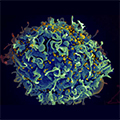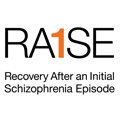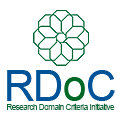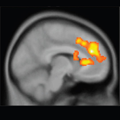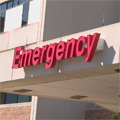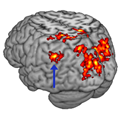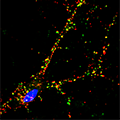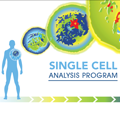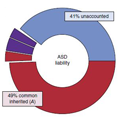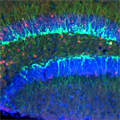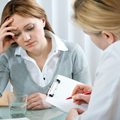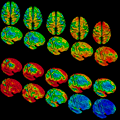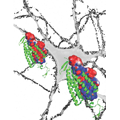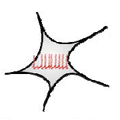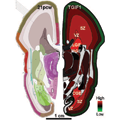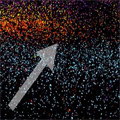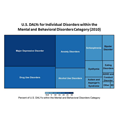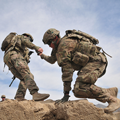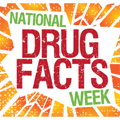Science News from 2014
- Seeking Single Cells’ Secrets
-
NIH has awarded grants totaling $7.9 million in 2014 to 25 research teams who are unraveling the workings of single cells.
- Despite Risks, Benzodiazepine Use Highest in Older People
-
Prescription use of benzodiazepines—a widely used class of sedative and anti-anxiety medications—increases steadily with age, despite the known risks for older people, according to a comprehensive analysis of benzodiazepine prescribing in the United States.
- Soldiers at Increased Suicide Risk after Leaving Hospital
-
Soldiers hospitalized with a psychiatric disorder have a higher suicide risk in the year following discharge from the hospital.
- Medications for Patients with First Episode Psychosis May Not Meet Guidelines
-
Many patients with first-episode psychosis receive medications that do not meet guidelines. A study finds that almost 40 % of people with first-episode psychosis in community mental health clinics across the country might benefit from medication treatment changes.
- RDoC Webinar Series Kickoff Event with Dr. Bruce Cuthbert
-
Dr. Bruce Cuthbert, director of the RDoC unit, kicks off the new RDoC Webinar Series by discussing the guiding principles of RDoC and answering viewers’ questions during a live Q&A period.
- Largest Autism Gene Dragnet Fingers 33 Prime Suspects
-
Many patients with psychosis develop health risks associated with premature death early in the course of their mental illness, researchers have found.
- NIMH Website Goes Mobile
-
An increasing number of U.S. adults connect to the web through smartphones or a tablets, according to a recent study by the Pew Research Internet Project. With NIMH’s new mobile-friendly website, visitors can access NIMH information and resources anywhere, anytime, and on any device—from desktop computers to tablets and mobile phones.
- NIMH Creates New Unit to Support Its Research Domain Criteria Initiative
-
NIMH announces a new unit within the Office of the Director to support the development of the institute’s Research Domain Criteria initiative. The unit will enhance communication with scientists, clinicians, and the public to refine the RDoC research framework and accelerate the translation of basic research into clinical treatments.
- Rapid Agent Restores Pleasure-seeking Ahead of Other Antidepressant Action
-
A drug being studied as a fast-acting mood-lifter restored pleasure-seeking behavior independent of – and ahead of – its other antidepressant effects.
- Groundbreaking Suicide Study
-
A groundbreaking study will help researchers learn more about treating people with suicidal thoughts. Nearly 20,000 patients will be able to enroll in the trial. One of the treatments being tested was developed with the help of other patients
- Increased Health Risks Linked to First-episode Psychosis
-
Many patients with psychosis develop health risks associated with premature death early in the course of their mental illness, researchers have found.
- New Report Provides National Clinical Data on the Prevalence of Many Specific Mental Disorders
-
The Substance Abuse and Mental Health Services Administration released the findings of a new clinical study providing national data on the past-year prevalence of specific mental disorders in adults.
- NIH Announces First Wave of Funding for BRAIN Initiative Research
-
Calling it “the beginning of an ambitious journey”, the National Institutes of Health announced its first wave of grants in support of the BRAIN Initiative.
- NIMH Twitter Chat on Depression and the Development of Novel Medications
-
NIMH Twitter Chat on Depression and the Development of Novel Medications
- Personalized Screen to ID Suicidal Teens in 14 ERs
-
A new study will develop and test a personalized, computer-based suicide risk screening tool to help ERs identify troubled teenagers.
- New Grants Fund Cross-lifespan Services Research for Autism Spectrum Disorder
-
NIH-funded projects aim at improving access, timeliness of interventions.
- Magnetic Stimulation Boosts Human Memory, Network Connectivity
-
Scientists have improved memory for associations between faces and words by electromagnetically stimulating neural connections in a brain network.
- Suspect Gene Corrupts Neural Connections
-
Researchers have shown in patients’ cells how a rare mutation in a suspect gene disrupts the expression of dozens of other genes underlying neural connections.
- Follow that Cell
-
The National Institutes of Health is challenging science innovators to compete for prizes totaling up to $500,000, by developing new ways to track the health status of a single cell in complex tissue over time.
- NIMH Twitter Chat on Premenstrual Dysphoric Disorder
-
NIMH Twitter Chat on Premenstrual Dysphoric Disorder
- Schizophrenia’s Genetic “Skyline” Rising
-
The largest genomic dragnet of any psychiatric disorder to date has unmasked 108 chromosomal sites harboring inherited variations in the genetic code linked to schizophrenia, 83 of which had not been previously reported.
- Common Gene Variants Account for Most Genetic Risk for Autism
-
Most of the genetic risk for autism comes from versions of genes that are common in the population rather than from rare variants or spontaneous glitches.
- How Might New Neurons Buffer Against Stress?
-
Over the past decade or so, evidence has emerged suggesting that the birth of new neurons in the adult brain’s memory hub, or hippocampus, may play a key role the action of antidepressants, resilience to stress, the benefits of exercise and enriched environments, and preventing memory loss. But understanding how it might work has remained elusive. NIMH researchers in NIH’s new Porter Neuroscience Research Center are following up leads.
- Shining a Light on Memory
-
Using a flash of light, scientists have inactivated and then reactivated a memory in genetically engineered rats. The findings – the first cause-and-effect evidence that strengthened connections between neurons are the stuff of memory – add to mounting evidence that the brain represents a memory by forming assemblies of neurons with strengthened connections.
- For Schizophrenia, Newer Injectables Not Necessarily Better
-
Treatment adherence is a problem among people with schizophrenia, who may not take medications because they don’t perceive its need or benefit, don’t like the side effects, or forget. To combat this issue, long-acting injectable medications are administered every 2-4 weeks. But are the new forms of these drugs better than the old ones?
- Genes Impact Suspect Cortex Areas More as Youth Mature
-
Later evolving and maturing brain areas, which also are those most implicated in mental illness, showed gradually increasing heritability, peaking by late adolescence – the age-of-onset for most mental disorders. New findings hold promise for understanding how age plays an important role in gene-environment interactions that underlie the disorders.
- Channel Makeover Bioengineered to Switch Off Neurons
-
Scientists have bioengineered an enhancement to a cutting edge technology that provides instant control over brain circuit activity with a flash of light. The research adds the same level of control over switching neurons off that, until now, had been limited to switching them on. What had been working through a weak pump now works through a highly responsive channel -- like going from a squirt to a gushing hose.
- NIMH’s Dr. Robert Heinssen Receives Special Presidential Commendation from APA
-
NIMH’s Dr. Robert Heinssen Receives Special Presidential Commendation from APA
- NIMH Twitter Chat on Autism Spectrum Disorder Diagnosis
-
NIMH Twitter Chat on Autism Spectrum Disorder Diagnosis
- Jump-starting Natural Resilience Reverses Stress Susceptibility
-
Scientists have traced vulnerability to depression-like behaviors to out-of-balance neuronal electrical activity and made mice resilient by reversing it.
- Learn About the Adolescent Brain with Expert Dr. Jay Giedd on May 8!
-
NIMH expert Dr. Jay Giedd will discuss the developing adolescent brain at a community event on May 8. The event will be video archived.
- NIH-funded Brain Atlas Offers Clues to Psychiatric Disorders
-
A brain blueprint maps where genes are tuned on and off during mid-pregnancy—when most brain disorders such as autism and schizophrenia occur.
- The 22nd NIMH Conference on Mental Health Services Research
-
The 22nd National Institute of Mental Health (NIMH) Conference on Mental Health Services Research (MHSR): Research in Pursuit of a Learning Mental Health Care System, will be convened on April 23–25, 2014, at the Natcher Conference Center on the National Institutes of Health (NIH) Campus, Bethesda, MD.
- Most Individuals Receive Health Services a Year Before Suicide Death
-
Undetected suicide risk is a critical issue in primary care. According to a NIMH-funded study published in the February 2014 issue of the Journal of General Internal Medicine, 83 percent of individuals received health care services in the year prior to suicide death and half did not have a mental health diagnosis.
- Disorganized Cortical Patches Suggest Prenatal Origin of Autism
-
The architecture of the autistic brain is speckled with patches of abnormal neurons, according to research partially funded by the National Institute of Mental Health, published in the New England Journal of Medicine on March 27, 2014.
- NIMH Scientists Help Students Learn About the Brain at NMHM
-
NIMH scientists presented hands-on demonstrations of neural electrical activity at the National Museum of Health and Medicine Brain Awareness Week program, March 12, 2014.
- Brain Region Singled Out for Social Memory, Possible Therapeutic Target for Select Brain Disorders
-
The hippocampus houses learning and memory—specifically the storage of knowledge of who, what, where, and when. Using a special transgenic mouse, researchers have now pinpointed a hippocampal region called CA2 that is important for social memory, the ability of animal to recognize another of the same species. Understanding this region could be useful in understanding and treating disorders characterized by altered social behaviors such as schizophrenia, bipolar disorder, and autism.
- Girls Thrive Emotionally, Boys Falter After Move to Better Neighborhood
-
Girls in public housing benefited emotionally from a move to a better neighborhood while boys fared worse than if they’d stayed in the poor neighborhood. Rates of depression and conduct disorder markedly increased in boys and decreased in girls. Boys also experienced significantly increased rates of post-traumatic stress disorder (PTSD), complicating housing policy decision-making.
- Announcing New U.S. Disability Statistics on the NIMH Website
-
NIMH announces updated World Health Organization estimates of the burden of disease in the United States.
- Students Unlock the Mysteries of the Brain with NIH Scientists
-
As part of Brain Awareness Week 2014, scientists from seven NIH institutes will sponsor hands-on activities—aimed at helping students learn about the brain—at the National Museum of Health and Medicine in Silver Spring, MD
- Suicide in the Military: Army-NIH Funded Study Points to Risk and Protective Factors
-
Although the suicide attempt and death rates in the U.S. Army have been historically below the civilian rate, these rates began climbing in the early 2000s, and by 2008, exceeded those of civilians. A joint study between the Army and NIMH, called Army STARRS, recently released findings that shed light on the problem.
- Healthy People 2020 Webinar
-
Healthy People 2020 Webinar: Substance Use and Mental Disorders: Early Detection, Prevention, and Treatment
- NICHD/NIMH Podcast on Youth Violence
-
NIMH/NICHD experts explain what sparks and halts youth violence.

